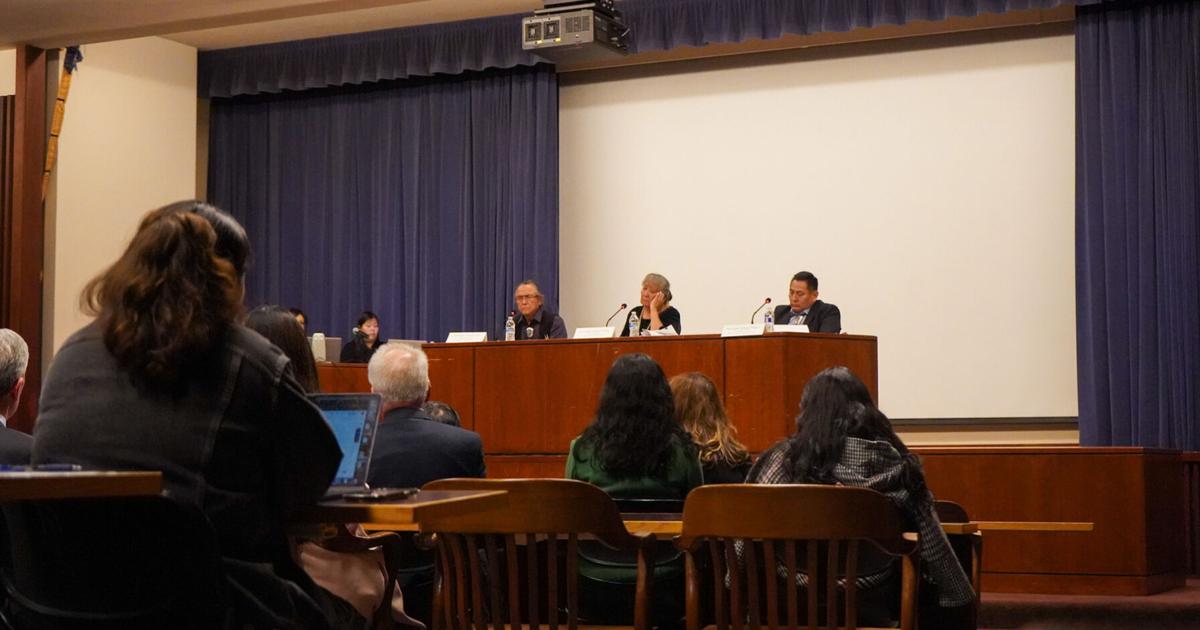The Navajo Nation Supreme Court heard the case of Dalgai v. Dalgai in the UC Berkeley School of Law’s Booth Auditorium on Wednesday. The hearing, sponsored by the Center for Indigenous Law and Justice at UC Berkeley, Berkeley Law and Native American Thriving Initiatives, drew a crowd of about 100.
The Supreme Court represents the highest appellate court in the judicial branch of Navajo Nation’s three-branch government and comprises a three-justice panel, led by Interim Chief Justice Eleanor Shirley. It distinguishes itself from other U.S. courts in that it uses the “Diné bi beenahaz’aanii” — the fundamental law of the people, comprising Navajo traditional, customary and natural law — in adjudicating cases, according to the Navajo Nation Judicial Branch website.
“This is a really great opportunity to get different perspectives and collaborate on issues related to tribal justice systems and programs,” said Navajo Nation Supreme Court Associate Justice William Platero.
The hearing coincided with a roundtable discussion between tribal, state and federal judges held the next day. The events marked the inauguration of what UC Berkeley’s Center for Indigenous Law and Justice plans to make an annual event.
The Diné bi beenahaz’aanii proved a key focus of the hearing Wednesday, as counsel debated whether an estate belonging to an Albert Lee Dalgai should pass down to his daughter-in-law or to his stepson. Both sides debated whether the traditional Navajo marriage of Albert’s wife to her first husband, which was never formally ended, invalidated her marriage to Albert, or whether its traditional informal ending allowed for the later marriage’s validity.
“This case kind of represents the clash of cultures here. Anglo law is starting to be written down into Navajo statute … and it needs to reflect a people for whom the law has generally not been written,” said Appellee Counsel Robyn L. Interpreter in the hearing.
Navajo fundamental values remained prevalent throughout the hearing as justices questioned Appellant Counsel Judy Apachee about whether her client, Diane Dalgai, could best keep the land for her relatives.
At one point during the hearing, Interpreter choked up with tears discussing the passing of Albert’s wife, Elizabeth Dalgai, saying, “She was a good lady.”
After the hearing, the justices spoke about the structure of the Navajo court. Chief Justice Emeritus and sitting Associate Justice Robert Yazzie spoke about the court’s Peacemaking Program.
Part of the consideration of fundamental law for the Navajo Courts lies in the pursuit of “hózh̨̨ó,” or harmony, which the Peacemaking Program aims to provide through facilitating open conversations between parties in dispute, Yazzie said.
“Wouldn’t it be well to give more deference to our (fundamental law)?” Yazzie asked after the hearing. “In the end we see a relationship; in the end we see a difference.”
Yazzie said peacemaking provides a space to discuss problems without a lawyer or judge present, to use the Diné bi beenahaz’aanii to come to a resolution that comes from the people.
When asked about the apparent conflict between Western written law and Navajo traditional values and practices raised in the case Wednesday, Yazzie said, “Don’t even mention conflicts. Accept what you’re told. It’s just another dimension to understand what is to be understood as a problem. There’s different ways of understanding.”

